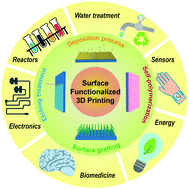Surface functionalization – a new functional dimension added to 3D printing
Abstract
Various requirements for 3D printing raised by actual applications in different fields have provoked the rapid development of technologies together with various specific materials. A protocol combining 3D printing with surface modification has stood out recently due to its outstanding capabilities to meet requirements in fields where surface properties are critical, allowing the surface performances of 3D-printed architectures to be controlled. So-called surface-functionalized 3D printing, via adding a new functional dimension to the surface of 3D-printed objects, is believed to be a robust, time-saving, cost-effective, and highly desirable approach for 3D printing, meeting a variety of demands, compared to developing special-purpose materials for each solo case. The general strategy and methods, including etching, deposition processing, micro-/nano-composition coating, and polymer brush assisted surface modification, are summarized in this review, as are the various applications and feasibilities for use in biomedicine, engineering, flexible electronics, smart devices, and so forth, due to the acquired features originating from postprocessing, including wettability, biocompatibility and bioactivity, high strength and conductivity, etc.



 Please wait while we load your content...
Please wait while we load your content...